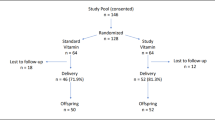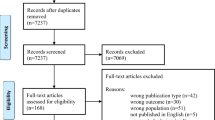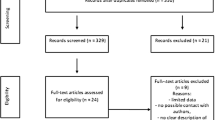Abstract
Objective:
Daily provision of pregnant patients with dietary supplements containing antioxidants and phytonutrients, if initiated in the first trimester of pregnancy and continued throughout the gestation, may significantly decrease the incidence of preeclampsia.
Study Design:
We conducted a single center, randomized, placebo-controlled investigation in which women were randomized by their risk status and assigned to daily ingestion of a supplement consisting primarily of a blended fruit and vegetable juice powder concentrate or placebo.
Result:
Of the 684 patients randomized to the trial, 267 (39.0%) completed it. The final analysis is based on those participants who completed the study. For the primary outcome of preeclampsia, there was no difference observed between the phytonutrient supplement group and the placebo group: 15.9% vs 16.3%, respectively, (R.R. 0.97 (0.56–1.69)). Non-significant trends toward lower placenta-related obstetrical complications were observed in the supplement group compared with the placebo cohort (8.3% vs 15.5%, respectively, (R.R. 0.57 (0.29–1.14). Those infants born to mothers taking the supplement in the high-risk stratified group demonstrated non-significant trends toward lower rates of respiratory distress syndrome (RDS); 5.3% in the supplement group vs 15.4% in the placebo group: R.R. 0.34 (0.12–1.01).
Conclusion:
Initiation of antioxidant/phytonutrient supplementation in the first trimester did not decrease rates of preeclampsia. Non-significant trends toward lower incidences of placental derived morbidity in those mothers taking the supplement in addition to decreased rates of RDS in infants born to supplemented mothers considered to be high-risk for preeclampsia, warrant further investigation.
This is a preview of subscription content, access via your institution
Access options
Subscribe to this journal
Receive 12 print issues and online access
$259.00 per year
only $21.58 per issue
Buy this article
- Purchase on Springer Link
- Instant access to full article PDF
Prices may be subject to local taxes which are calculated during checkout

Similar content being viewed by others
References
Genbacev O, Miller RK . Post-implantation differentiation and proliferation of cytotrophoblast cells: In vitro models—a review. Placenta 2000; 21, Supplement A, Trophoblast Research S45–S49.
Hustin J, Schaaps J-P . Echocardiographic and anatomic studies of the maternotrophoblastic border during the first trimester of pregnancy. Am J Obstet Gynecol 1987; 157: 162–168.
Hustin J, Jauniaux E, Schaaps J-P . Histological study of the materno-embryonic interface in spontaneous abortion. Placenta 1990; 11: 477–486.
Jauniaux E, Jurkovic D, Campbell S . In vivo investigations of the anatomy and the physiology of early human placental circulations. Ultrasound Obstet Gynecol 1991; 1: 435–445.
Burton GJ, Jauniaux E, Watson AL . Maternal arterial connections to the placental intervillous space during the first trimester of human pregnancy: The Boyd Collection revisited. Am J Obstet Gynecol 1999; 181: 718–724.
Jauniaux E, Watson AL, Hempstock J, Bao Y-P, Skepper JN, Burton GJ . Onset of maternal arterial blood flow and placental oxidative stress. Am J Pathol 2000; 157: 2111–2122.
Jauniaux E, Zaidi J, Jurkovic D, Campbell S, Hustin J . Comparison of colour Doppler features and pathological findings in complicated early pregnancy. Hum Reprod 1994; 9: 2432–2437.
Jauniaux E, Watson A, Burton G . Evaluation of respiratory gases and acid-base gradients in human fetal fluids and uteroplacental tissue between 7 and 16 weeks' gestation. Am J Obstet Gynecol 2001; 184: 998–1003.
Walsh SW . Maternal-placental interactions of oxidative stress and antioxidants in preeclampsia. Sem Reprod Endocrinol 1998; 16: 93–104.
Chambers JC, Fusi L, Malik IS, Haskard DO, De Swiet M, Kooner JS . Association of maternal endothelial dysfunction with preeclampsia. JAMA 2001; 285: 1607–1612.
Dekker G, Sibai BM . Primary, secondary and tertiary prevention of preeclampsia. Lancet 2001; 357: 209–215.
Chappell LC, See PT, Briley AL, Kelly FJ, Lee R, Hunt BJ et al. Effect of antioxidants on the occurrence of preeclampsia in women at increased risk: a randomized trial. Lancet 1999; 354: 810–816.
Buhimschi IA, Weiner CP . Oxygen free radicals and disorders of pregnancy. Fet Mat Med Rev 2001; 12: 273–298.
Samman S, Sivarajah G, Man JC, Ahmad ZI, Petocz P, Caterson ID . A mixed fruit and vegetable concentrate increases plasma antioxidant vitamins and folate and lowers plasma homocysteine in men. J Nutr 2003; 133: 2188–2193.
Houston MC, Cooil B, Olafsson BJ, Raggi P . Juice powder concentrate and systemic blood pressure, progression of coronary artery calcium and antioxidant status in hypertensive subjects: a pilot study. Evid Based Complement Alternat Med 2007; 4: 455–462.
Plotnick GD, Corretti MC, Vogel RA, Hesslink R, Wise JA . Effect of supplemental phytonutrients on impairment of the flow-mediated brachial artery vasoactivity after a single high-fat meal. J Am Coll Cardiol. 2003; 41: 1744–1749.
Bloomer RJ, Goldfarb AH, McKenzie MJ . Oxidative stress response to aerobic exercise: comparison of antioxidant supplements. Med Sci Sports Exerc 2006; 38: 1098–1105.
Nantz MP, Rowe CA, Nieves C, Percival SS . Immunity and antioxidant capacity in humans is enhanced by consumption of a dried, encapsulated fruit and vegetable juice concentrate. J. Nutr. 2006; 136: 2606–2610.
Terrone DA, Rinehart BK, May WL, Martin RW, Martin JN . The myth of transient hypertension: descriptor or disease process? Am J Perinatol 2001; 18: 73–77.
Roberts JM, Hubel CA . Is oxidative stress the link in the two-stage model of preeclampsia? Lancet 1999; 354: 788–789.
Roberts JM . Redman CWG. Preeclampsia: more than pregnancy-induced hypertension. Lancet 1993; 341: 1447–1451.
Roberts JM . Preeclampsia: what we know and what we don't know. Sem Perinatol 2000; 24: 24–28.
Roberts JM, Lain KY . Recent insights into the pathogenesis of preeclampsia. Placenta 2002; 23: 359–372.
Hubel CA, Roberts JM, Taylor RN, Musci TJ, Rogers GM, McLaughlin MK . Lipid peroxidation in pregnancy: new perspectives on preeclampsia. Am J Obstet Gynecol 1989; 161: 1025–1034.
Roberts JM, Roberts NT, Musci TJ, Roberts GM, Hubel CA, McLaughlin MK . Preeclampsia: an endothelial cell disorder. Am J Obstet Gynecol 1989; 161: 1200–1204.
Halliwell B . Free radicals, reactive oxygen species and human disease: a critical evaluation with special reference to atherosclerosis. Br J Exp Pathol 1989; 70: 737–757.
Hubel CA . Dyslipidemia, iron, and oxidative stress in preeclampsia: assessment of maternal and feto-placental interactions. Sem Reprod Endocrinol 1998; 16: 75–92.
Sattar N, Gaw A, Packard CJ, Greer IA . Potential pathogenic roles of aberrant lipoprotein and fatty acid metabolism in preeclampsia. Brit J Obstet Gynaecol 1996; 103: 614–620.
Hubel CA . Oxidative stress in the pathogenesis of preeclampsia. Proc Soc Exp Biol Med 1999; 222: 222–235.
Kelly B, Stone S, Poston L . Cardiovascular adaptation to pregnancy: the role of altered vascular structure. Fet Mat Med Rev 1999; 11: 105–116.
Carbillon L, Uzan M, Uzan S . Pregnancy, vascular tone and maternal hemodynamics: a crucial adaptation. Ob Gyn Surv 2000; 55: 574–581.
Higashi Y, Sasaki S, Nakagawa K, Matsuura H, Oshima T, Chayama K . Endothelial function and oxidative stress in renovascular hypertension. N Engl J Med 2002; 346: 1954–1962.
Poston L, Briley AL, Seed PT, Kelly JF, Shennan AH . Vitamin C and vitamin E in pregnant women at risk for preeclampsia (VIP Trial): randomized placebo-controlled trial. Lancet 2006; 367: 1145–1154.
Kalpdev A, Saha SC, Dhawan V . Vitamin C and E supplementation does not reduce the risk of superimposed preeclampsia in pregnancy. Hypertension Pregnancy 2011; 30: 447–456.
McCance DR, Holmes VA, Maresh MJ, Patterson CC, Walker JD, Pearson DWM et al. Vitamins C and E for the prevention of preeclampsia in women with type 1 diabetes (DAPIT): a randomised placebo-controlled trial. Lancet 2010; 376: 259–266.
Roberts JM, Myatt L, Spong CY, Thom EA, Hauth JC, Leveno KJ et al. Vitamins C and E to prevent complications of pregnancy-associated hypertension. N Eng J Med 2010; 362: 1282–1291.
Xu H, Perez-Cuevas R, Xiong X, Reyes H, Roy C, Julien P et al. An international trial of antioxidants in the prevention of preeclampsia (INTAPP). Am J Obstet Gynecol 2010; 202: 239.e1–10.
Rumbold AR, Crowther CA, Haslam RR, Dekker GA, Robinson JS . Vitamins C and E and the risks of preeclampsia and perinatal complications. N Eng J Med 2006; 354: 1796–1806.
Spinnato JA, Freire S, Silva JL, Cunha Rudge MV, Martins-Costa S, Koch MA et al. Antioxidant therapy to prevent preeclampsia. J Obstet Gynecol 2007; 110: 1311–1318.
Gitto E, Reiter RJ, Karbownik M, Xian-Tan D, Barberi I . Respiratory distress syndrome in the newborn: role of oxidative stress. Intensive Care Med 2001; 27: 1116–1123.
Mikhail MS, Anyaegbunam A, Garfinkel D, Palan PR, Basu J, Romney S . Preeclampsia and antioxidant nutrients: decreased plasma levels of reduced ascorbic acid, alpha-tocopherol, and beta-carotene in women with preeclampsia. J Obstet Gynecol 1994; 171: 150–157.
Rumiris D, Purwosunu Y, Wibowo N, Farina A, Sekizawa A . Lower rate of preeclampsia after antioxidant supplementation in pregnant women with low antioxidant status. Hyperten Pregnancy 2006; 25: 241–253.
Acknowledgements
NSA, LLC provided funding for the entire investigation.
Author information
Authors and Affiliations
Corresponding author
Ethics declarations
Competing interests
The authors declare no conflict of interest.
Additional information
This paper was presented orally at the 79th Annual Meeting of the Central Association of Obstetricians and Gynecologists in Chicago, IL. The meeting commenced on Wednesday October 17th 2012 and ended on Saturday October 20th 2012.
Rights and permissions
About this article
Cite this article
Parrish, M., Martin, J., Lamarca, B. et al. Randomized, placebo controlled, double blind trial evaluating early pregnancy phytonutrient supplementation in the prevention of preeclampsia. J Perinatol 33, 593–599 (2013). https://doi.org/10.1038/jp.2013.18
Received:
Revised:
Accepted:
Published:
Issue Date:
DOI: https://doi.org/10.1038/jp.2013.18
Keywords
This article is cited by
-
Micronutrient supplementation interventions in preconception and pregnant women at increased risk of developing pre-eclampsia: a systematic review and meta-analysis
European Journal of Clinical Nutrition (2023)



